The Structure of Riparian Vegetation in Agricultural Landscapes Influences Spider Communities and Aquatic-Terrestrial Linkages
Abstract
1. Introduction
- Riparian spider community composition differs between buffered, unbuffered and forest sites. This hypothesis reflects an expectation of lower abundances of web-building spiders in particular at unbuffered sites, due to the deficiency of vegetation structures suitable for building webs, with spider diversity and abundance expected to increase overall with increases in riparian forest cover, due to a larger variation in available habitat niches.
- Consistent with more favorable conditions for algae that produce long-chain PUFAs, higher concentrations of long-chain PUFAs (e.g., EPA) will be found in spiders from forested sites (buffered and forest reference sites) than the unbuffered agricultural sites; and
- Spider taxonomic groups shown to be highly reliant on aquatic subsidies, such as the Tetragnathidae and Lycosidae, have increased long-chain PUFA content reflecting greater consumption of aquatic-derived prey.
2. Materials and Methods
2.1. Study Sites
2.2. Habitat Assessment
2.3. Riparian Spiders
2.4. Invertebrate Identification, Biomass and Fatty Acid Pre-Processing
2.5. Fatty Acid Analysis
2.6. Data Analysis
3. Results
3.1. Habitat Characterisation of the Site Types
3.2. Riparian Spider Diversity and Community Composition
3.3. Relationships between Habitat and Spider Community Composition
3.4. General Fatty Acid Profiles of Riparian Spiders
3.5. Specific Polyunsaturated Fatty Acids
4. Discussion
4.1. Riparian Spider Communities
4.2. Fatty Acid Concentrations and Profiles in Riparian Spiders
4.3. The Transfer of Aquatic PUFAs into Terrestrial Food Webs, and Implications for Management
5. Conclusions
Supplementary Materials
Author Contributions
Funding
Acknowledgments
Conflicts of Interest
References
- Biggs, J.; Von Fumetti, S.; Kelly-Quinn, M. The Importance of Small Waterbodies for Biodiversity and Ecosystem Services: Implications for Policy Makers. Hydrobiologia 2017, 793, 3–39. [Google Scholar] [CrossRef]
- Keeler, B.L.; Polasky, S.; Brauman, K.A.; Johnson, K.A.; Finlay, J.C.; O’Neill, A.; Kovacs, K.; Dalzell, B. Linking Water Quality and Well-Being for Improved Assessment and Valuation of Ecosystem Services. Proc. Natl. Acad. Sci. USA 2012, 109, 18619–18624. [Google Scholar] [CrossRef] [PubMed]
- Naiman, R.J.; Décamps, H. The Ecology of Interfaces: Riparian Zones. Annu. Rev. Ecol. Syst. 1997, 28, 621–658. [Google Scholar] [CrossRef]
- Wenger, S. A Review of the Scientific Literature on Riparian Buffer Width, Extent and Vegetation; Institute of Ecology: Athens, GA, USA, 1999. [Google Scholar]
- Polis, G.A.; Anderson, W.B.; Holt, R.D. Toward an Integration pf Landscape and Food Web Ecology: The Dynamics of Spatially Subsidized Food Webs. Annu. Rev. Ecol. Syst. 1997, 28, 289–316. [Google Scholar] [CrossRef]
- Baxter, C.V.; Fausch, K.D.; Saunders, W.C. Tangled Webs: Reciprocal Flows of Invertebrate Prey Link Streams and Riparian Zones. Freshw. Biol. 2005, 50, 201–220. [Google Scholar] [CrossRef]
- Gladyshev, M.; Brett, M.T.; Arts, M.T.; Sushchik, N. Preliminary Estimates of the Export of Omega-3 Highly Unsaturated Fatty Acids (EPA+DHA) from Aquatic to Terrestrial Ecosystems. In Lipids in Aquatic Ecosystems; Springer Science and Business Media LLC: New York, NY, USA, 2009; pp. 179–210. [Google Scholar]
- Muehlbauer, J.D.; Collins, S.F.; Doyle, M.W.; Tockner, K. How Wide Is a Stream? Spatial Extent of the Potential “Stream Signature” in Terrestrial Food Webs Using Meta-Analysis. Ecology 2014, 95, 44–55. [Google Scholar] [CrossRef]
- Schindler, D.E.; Smits, A.P. Subsidies of Aquatic Resources in Terrestrial Ecosystems. Ecosystems 2017, 20, 78–93. [Google Scholar] [CrossRef]
- Bell, M.; Henderson, R.; Sargent, J. The Role of Polyunsaturated Fatty Acids in Fish. Comp. Biochem. Physiol. Part B Comp. Biochem. 1986, 83, 711–719. [Google Scholar] [CrossRef]
- Müller-Navarra, D.C.; Brett, M.T.; Liston, A.M.; Goldman, C.R. A Highly Unsaturated Fatty Acid Predicts Carbon Transfer Between Primary Producers and Consumers. Nat. Cell Biol. 2000, 403, 74–77. [Google Scholar] [CrossRef]
- Twining, C.W.; Brenna, J.; Hairston, N.G.; Flecker, A.S. Highly Unsaturated Fatty Acids in Nature: What We Know and What We Need to Learn. Oikos 2016, 125, 749–760. [Google Scholar] [CrossRef]
- Taipale, S.; Strandberg, U.; Peltomaa, E.; Galloway, A.; Ojala, A.; Brett, M. Fatty Acid Composition as Biomarkers of Freshwater Microalgae: Analysis of 37 Strains of Microalgae in 22 Genera and in Seven Classes. Aquat. Microb. Ecol. 2013, 71, 165–178. [Google Scholar] [CrossRef]
- Funck, J.A.; Bec, A.; Perrière, F.; Felten, V.; Danger, M. Aquatic Hyphomycetes: A Potential Source of Polyunsaturated Fatty Acids in Detritus-Based Stream Food Webs. Fungal Ecol. 2015, 13, 205–210. [Google Scholar] [CrossRef]
- Chari, L.; Richoux, N.; Moyo, S.; Villet, M. Dietary Fatty Acids of Spiders Reveal Spatial and Temporal Variations in Aquatic-Terrestrial Linkages. Food Webs 2020, 24, e00152. [Google Scholar] [CrossRef]
- Richardson, J.S.; Zhang, Y.; Marczak, L.B. Resource Subsidies Across the Land-Freshwater Interface and Responses in Recipient Communities. River Res. Appl. 2009, 26, 55–66. [Google Scholar] [CrossRef]
- Allan, J.D. Landscapes and Riverscapes: The Influence of Land Use on Stream Ecosystems. Annu. Rev. Ecol. Evol. Syst. 2004, 35, 257–284. [Google Scholar] [CrossRef]
- Corbacho, C.; Sánchez, J.M.; Costillo, E. Patterns of Structural Complexity and Human Disturbance of Riparian Vegetation in Agricultural Landscapes of a Mediterranean Area. Agric. Ecosyst. Environ. 2003, 95, 495–507. [Google Scholar] [CrossRef]
- Ollero, A. Channel Adjustments, Floodplain Changes and Riparian Ecosystems of the Middle Ebro River: Assessment and Management. Int. J. Water Resour. Dev. 2007, 23, 73–90. [Google Scholar] [CrossRef]
- Renouf, K.; Harding, J.S. Characterising Riparian Buffer Zones of an Agriculturally Modified Landscape. N. Z. J. Mar. Freshw. Res. 2015, 49, 323–332. [Google Scholar] [CrossRef]
- Carlson, P.E.; McKie, B.G.; Sandin, L.; Johnson, R.K. Strong Land-Use Effects on the Dispersal Patterns of Adult Stream Insects: Implications for Transfers of Aquatic Subsidies to Terrestrial Consumers. Freshw. Biol. 2016, 61, 848–861. [Google Scholar] [CrossRef]
- Laeser, S.R.; Baxter, C.V.; Fausch, K.D. Riparian Vegetation Loss, Stream Channelization, and Web-Weaving Spiders in Northern Japan. Ecol. Res. 2005, 20, 646–651. [Google Scholar] [CrossRef]
- Guo, F.; Kainz, M.J.; Sheldon, F.; Bunn, S.E. The Importance of High-Quality Algal Food Sources in Stream Food Webs—Current Status and Future Perspectives. Freshw. Biol. 2016, 61, 815–831. [Google Scholar] [CrossRef]
- Burdon, F.J.; Harding, J.S. The Linkage Between Riparian Predators and Aquatic Insects Across a Stream-Resource Spectrum. Freshw. Biol. 2007, 53, 330–346. [Google Scholar] [CrossRef]
- Collier, K.J.; Smith, B.J. Interactions of Adult Stoneflies (Plecoptera) with Riparian Zones I. Effects of Air Temperature and Humidity on Longevity. Aquat. Insects 2000, 22, 275–284. [Google Scholar] [CrossRef]
- Hill, W.R.; Ryon, M.G.; Schilling, E.M. Light Limitation in a Stream Ecosystem: Responses by Primary Producers and Consumers. Ecology 1995, 76, 1297–1309. [Google Scholar] [CrossRef]
- Stelzer, R.S.; Lamberti, G.A. Effects of N: P Ratio and Total Nutrient Concentration on Stream Periphyton Community Structure, Biomass, and Elemental Composition. Limnol. Oceanogr. 2001, 46, 356–367. [Google Scholar] [CrossRef]
- Allan, J.D.; Castillo, M.M.I. Stream Ecology: Structure and Function of Running Waters, 2nd ed.; Springer: Dordrecht, The Netherlands, 2009; ISBN 978-1-4020-5582-9. [Google Scholar]
- Larned, S.T. A Prospectus for Periphyton: Recent and Future Ecological Research. J. N. Am. Benthol. Soc. 2010, 29, 182–206. [Google Scholar] [CrossRef]
- Richardson, J.S.; Danehy, R.J. A Synthesis of the Ecology of Headwater Streams and their Riparian Zones in Temperate Forests. For. Sci. 2007, 53, 131–147. [Google Scholar] [CrossRef]
- Law, R.J. A Review of the Function and Uses of, and Factors Affecting, Stream Phytobenthos. Freshw. Rev. 2011, 4, 135–166. [Google Scholar] [CrossRef]
- Torres-Ruiz, M.; Wehr, J.D.; Perrone, A.A. Trophic Relations in a Stream Food Web: Importance of Fatty Acids for Macroinvertebrate Consumers. J. N. Am. Benthol. Soc. 2007, 26, 509–522. [Google Scholar] [CrossRef]
- Gladyshev, M.I.; Sushchik, N.N.; Makhutova, O.N. Production of EPA and DHA in Aquatic Ecosystems and Their Transfer to the Land. Prostaglandins Other Lipid Mediat. 2013, 107, 117–126. [Google Scholar] [CrossRef]
- Hill, W.R.; Rinchard, J.; Czesny, S. Light, Nutrients and the Fatty Acid Composition of Stream Periphyton. Freshw. Biol. 2011, 56, 1825–1836. [Google Scholar] [CrossRef]
- Krell, B.; Röder, N.; Link, M.; Gergs, R.; Entling, M.H.; Schäfer, R.B. Aquatic Prey Subsidies to Riparian Spiders in a Stream with Different Land Use Types. Limnologica 2015, 51, 1–7. [Google Scholar] [CrossRef]
- Kato, C.; Iwata, T.; Nakano, S.; Kishi, D. Dynamics of Aquatic Insect Flux Affects Distribution of Riparian Web-Building Spiders. Oikos 2003, 103, 113–120. [Google Scholar] [CrossRef]
- Kato, C.; Iwata, T.; Wada, E. Prey Use by Web-Building Spiders: Stable Isotope Analyses of Trophic Flow at a Forest-Stream Ecotone. Ecol. Res. 2004, 19, 633–643. [Google Scholar] [CrossRef]
- Stenroth, K.; Polvi, L.E.; Fältström, E.; Jonsson, M. Land-Use Effects on Terrestrial Consumers Through Changed Size Structure of Aquatic Insects. Freshw. Biol. 2014, 60, 136–149. [Google Scholar] [CrossRef]
- Paetzold, A.; Schubert, C.J.; Tockner, K. Aquatic Terrestrial Linkages Along a Braided-River: Riparian Arthropods Feeding on Aquatic Insects. Ecosystems 2005, 8, 748–759. [Google Scholar] [CrossRef]
- Uppsala Kommun. Statistik om Uppsala Kommun 2018; Analysenheten: Uppsala, Sweeden, 2018. [Google Scholar]
- SMHI Månads-, årstids- och årskartor. Available online: https://www.smhi.se/klimatdata/meteorologi/kartor/monYrTable.php?par=tmpAvv (accessed on 15 April 2019).
- Burdon, F.J.; Ramberg, E.; Sargac, J.; Forio, M.A.E.; De Saeyer, N.; Mutinová, P.T.; Moe, T.F.; Pavelescu, M.O.; Dinu, V.; Cazacu, C.; et al. Assessing the Benefits of Forested Riparian Zones: A Qualitative Index of Riparian Integrity Is Positively Associated with Ecological Status in European Streams. Water 2020, 12, 1178. [Google Scholar] [CrossRef]
- Nentwig, W.; Blick, T.; Gloor, D.; Hänggi, A.; Kropf, C. Spiders of Europe, Version (9) 2018. Available online: https://araneae.nmbe.ch (accessed on 15 September 2018).
- Jocqué, R.; Dippenaar-Schoeman, A.S. Musée Royal de l’Afrique Centrale. In Spider Families of the World, 2nd ed.; Musée Royal de l’Afrique Centrale: Tervuren, Belgium, 2007; ISBN 978-90-74752-11-4. [Google Scholar]
- Kronestedt, T. Checklist of Swedish Spiders in Sweden. Available online: http://www2.nrm.se/en/svenska_spindlar/spindlar.html (accessed on 15 April 2019).
- Grieve, A.; Lau, D.C.P. Do Autochthonous Resources Enhance Trophic Transfer of Allochthonous Organic Matter to Aquatic Consumers, or Vice Versa? Ecosphere 2018, 9, e02307. [Google Scholar] [CrossRef]
- R Core Team. R: A Language and Environment for Statistical Computing; R Foundation for Statistical Computing: Vienna, Austria, 2018. [Google Scholar]
- Legendre, P.; Gallagher, E.D. Ecologically Meaningful Transformations for Ordination of Species Data. Oecologia 2001, 129, 271–280. [Google Scholar] [CrossRef]
- Oksanen, J.; Blanchet, F.G.; Friendly, M.; Kindt, R.; Legendre, P.; McGlinn, D.; Minchin, P.R.; O’Hara, R.B.; Simpson, G.L.; Solymos, P.; et al. Vegan: Community Ecology Package; Comprehensive R Archive Network: Berkely, CA, USA, 2019. [Google Scholar]
- Quinn, G.; Keough, M. Experimental Design and Data Analysis for Biologists, 1st ed.; Cambridge University Press: Cambridge, UK, 2002. [Google Scholar]
- Bates, D.; Mächler, M.; Bolker, B.; Walker, S. Fitting Linear Mixed-Effects Models Using lme4. J. Stat. Softw. 2015, 67, 1–48. [Google Scholar] [CrossRef]
- Frainer, A.; Polvi, L.E.; Jansson, R.; McKie, B.G. Enhanced Ecosystem Functioning Following Stream Restoration: The Roles of Habitat Heterogeneity and Invertebrate Species Traits. J. Appl. Ecol. 2017, 55, 377–385. [Google Scholar] [CrossRef]
- Hasselquist, E.M.; Polvi, L.E.; Kahlert, M.; Nilsson, C.; Sandberg, L.; McKie, B.G. Contrasting Responses among Aquatic Organism Groups to Changes in Geomorphic Complexity Along a Gradient of Stream Habitat Restoration: Implications for Restoration Planning and Assessment. Water 2018, 10, 1465. [Google Scholar] [CrossRef]
- Schultz, R.C.; Isenhart, T.M.; Simpkins, W.W.; Colletti, J.P. Riparian Forest Buffers in Agroecosystems—Lessons Learned from the Bear Creek Watershed, Central Iowa, USA. Agrofor. Syst. 2004, 61, 35–50. [Google Scholar]
- Naiman, R.J.; Décamps, H.; McClain, M.E. Riparia: Ecology, Conservation, and Management of Streamside Communities; Elsevier Science & Technology: Burlington, VT, USA, 2005; ISBN 978-0-08-047068-9. [Google Scholar]
- Clark, W.R.; Reeder, K.F. Agricultural Buffers and Wildlife Conservation: A Summary About Linear Practices. In Fish and Wildlife Response to Farmland Conservation Practices; The Wildlife Society: Bethesda, MD, USA, 2007; pp. 45–55. [Google Scholar]
- Degerman, E.; Bergqvist, B. Ekologiskt Funktionella Kantzoner. In Ekologisk Restaurering av Vattendrag; Degerman, E., Ed.; Naturvårdsverket och Fiskerieverket: Göteborg, Stockholm, 2008; pp. 33–52. [Google Scholar]
- Bjelke, U.; Boberg, J.; Oliva, J.; Tattersdill, K.; McKie, B.G. Dieback of Riparian Alder Caused by Thephytophthora Alnicomplex: Projected Consequences for Stream Ecosystems. Freshw. Biol. 2016, 61, 565–579. [Google Scholar] [CrossRef]
- McKie, B.G.; Sandin, L.; Carlson, P.E.; Johnson, R.K. Species Traits Reveal Effects of Land Use, Season and Habitat on the Potential Subsidy of Stream Invertebrates to Terrestrial Food Webs. Aquat. Sci. 2018, 80, 15. [Google Scholar] [CrossRef]
- Perner, J.; Malt, S. Assessment of Changing Agricultural Land Use: Response of Vegetation, Ground-Dwelling Spiders and Beetles to the Conversion of Arable Land into Grassland. Agric. Ecosyst. Environ. 2003, 98, 169–181. [Google Scholar] [CrossRef]
- Batáry, P.; Baldi, A.; Samu, F.; Szűts, T.; Erdős, S. Are Spiders Reacting to Local or Landscape Scale Effects in Hungarian Pastures? Biol. Conserv. 2008, 141, 2062–2070. [Google Scholar] [CrossRef]
- Prieto-Benítez, S.; Méndez, M. Effects of Land Management on the Abundance and Richness of Spiders: A Meta-Analysis. Biol. Conserv. 2011, 144, 683–691. [Google Scholar] [CrossRef]
- Chan, E.K.W.; Zhang, Y.; Dudgeon, D. Substrate Availability May Be More Important than Aquatic Insect Abundance in the Distribution of Riparian Orb-web Spiders in the Tropics. Biotropica 2009, 41, 196–201. [Google Scholar] [CrossRef]
- Nyffeler, M. Prey Selection of Spiders in the Field. J. Arachnol. 1999, 27, 317–324. [Google Scholar]
- Moring, J.B.; Stewart, K.W. Habitat Partitioning by the Wolf Spider Guild in Streamside and Riparian Vegetation Zones of the Conejos River, Colorado. J. Arachnol. 1994, 22, 205–217. [Google Scholar]
- Lambeets, K.; Hendrickx, F.; Vanacker, S.; Van Looy, K.; Maelfait, J.-P.; Bonte, D. Assemblage Structure and Conservation Value of Spiders and Carabid Beetles from Restored Lowland River Banks. Biodivers. Conserv. 2008, 17, 3133–3148. [Google Scholar] [CrossRef]
- Artdatabanken, SLU Artfakta spindlar. Available online: https://artfakta.artdatabanken.se (accessed on 21 April 2019).
- Supp, S.R.; Ernest, S.K.M. Species-Level and Community-Level Responses to Disturbance: A Cross-Community Analysis. Ecology 2014, 95, 1717–1723. [Google Scholar] [CrossRef] [PubMed]
- Burdon, F.J. Agriculture and Mining Contamination Contribute to a Productivity Gradient Driving Cross-Ecosystem Associations between Stream Insects and Riparian Arachnids. In Contaminants and Ecological Subsidies: The Land-Water Interface, 1st ed.; Kraus, J.M., Walters D., M., Mills, M.A., Eds.; Springer: New York, NY, USA, 2020; 384p. [Google Scholar]
- Moore, R.D.; Spittlehouse, D.L.; Story, A. Riparian Microclimate and Stream Temperature Response to Forest Harvesting: A Review. J. Am. Water Resour. Assoc. 2005, 41, 813–834. [Google Scholar] [CrossRef]
- Karlsson, D.; Hartop, E.A.; Forshage, M.; Jaschhof, M.; Ronquist, F. The Swedish Malaise Trap Project: A 15 Year Retrospective on a Countrywide Insect Inventory. Biodivers. Data J. 2020, 8, e47255. [Google Scholar] [CrossRef] [PubMed]
- Duffey, E. The Distribution, Status and Habitats of Dolomedes Fimbriatus (Clerck) and D. Plantarius (Clerck) in Europe; Ruzicka, V., Ed.; Institute of Entomology: Ceske Budejovice, Czech Republic, 1995; pp. 54–65. [Google Scholar]
- Lau, D.C.P.; Vrede, T.; Pickova, J.; Goedkoop, W. Fatty Acid Composition of Consumers in Boreal Lakes—Variation Across Species, Space and Time. Freshw. Biol. 2011, 57, 24–38. [Google Scholar] [CrossRef]
- Carlson, P.E.; Johnson, R.K.; McKie, B.G. Optimizing Stream Bioassessment: Habitat, Season, and the Impacts of Land Use on Benthic Macroinvertebrates. Hydrobiologia 2012, 704, 363–373. [Google Scholar] [CrossRef]
- Napolitano, G.E. The Relationship of Lipids with Light and Chlorophyll Measurements in Freshwater Algae and Periphyton1. J. Phycol. 1994, 30, 943–950. [Google Scholar] [CrossRef]
- Scholz, B.; Liebezeit, G. Biochemical Characterisation and Fatty Acid Profiles of 25 Benthic Marine Diatoms Isolated From the Solthörn Tidal Flat (Southern North Sea). J. Appl. Phycol. 2013, 25, 453–465. [Google Scholar] [CrossRef]
- Ahlgren, G.; Gustafsson, I.-B.; Boberg, M. Fatty Acid Content and Chemical Composition of Freshwater Microalgae. J. Phycol. 1992, 28, 37–50. [Google Scholar] [CrossRef]
- Cunnane, S. The Conditional Nature of the Dietary Need for Polyunsaturates: A Proposal to Reclassify ‘Essential Fatty Acids’ as ‘Conditionally-Indispensable’ or ‘Conditionally-Dispensable’ Fatty Acids. Br. J. Nutr. 2000, 84, 803–812. [Google Scholar] [CrossRef] [PubMed]
- Sunderland, K.D.; Fraser, A.M.; Dixon, A.F.G. Field and Laboratory Studies on Money Spiders (Linyphiidae) as Predators of Cereal Aphids. J. Appl. Ecol. 1986, 23, 433. [Google Scholar] [CrossRef]
- Riis, T.; Kelly-Quinn, M.; Aguiar, F.C.; Manolaki, P.; Bruno, D.; Bejarano, M.D.; Clerici, N.; Fernandes, M.R.; Franco, J.C.; Pettit, N.; et al. Global Overview of Ecosystem Services Provided by Riparian Vegetation. BioScience 2020, 70, 501–514. [Google Scholar] [CrossRef]
- Samways, M.J.; Barton, P.S.; Birkhofer, K.; Chichorro, F.; Deacon, C.; Fartmann, T.; Fukushima, C.S.; Gaigher, R.; Margules, C.; Hallmann, C.A.; et al. Solutions for Humanity on How to Conserve Insects. Biol. Conserv. 2020, 242, 108427. [Google Scholar] [CrossRef]
- Mutinova, P.T.; Kahlert, M.; Kupilas, B.; McKie, B.G.; Friberg, N.; Burdon, F.J. Benthic Diatom Communities in Urban Streams and the Role of Riparian Buffers. Water 2020, 12, 2799. [Google Scholar]
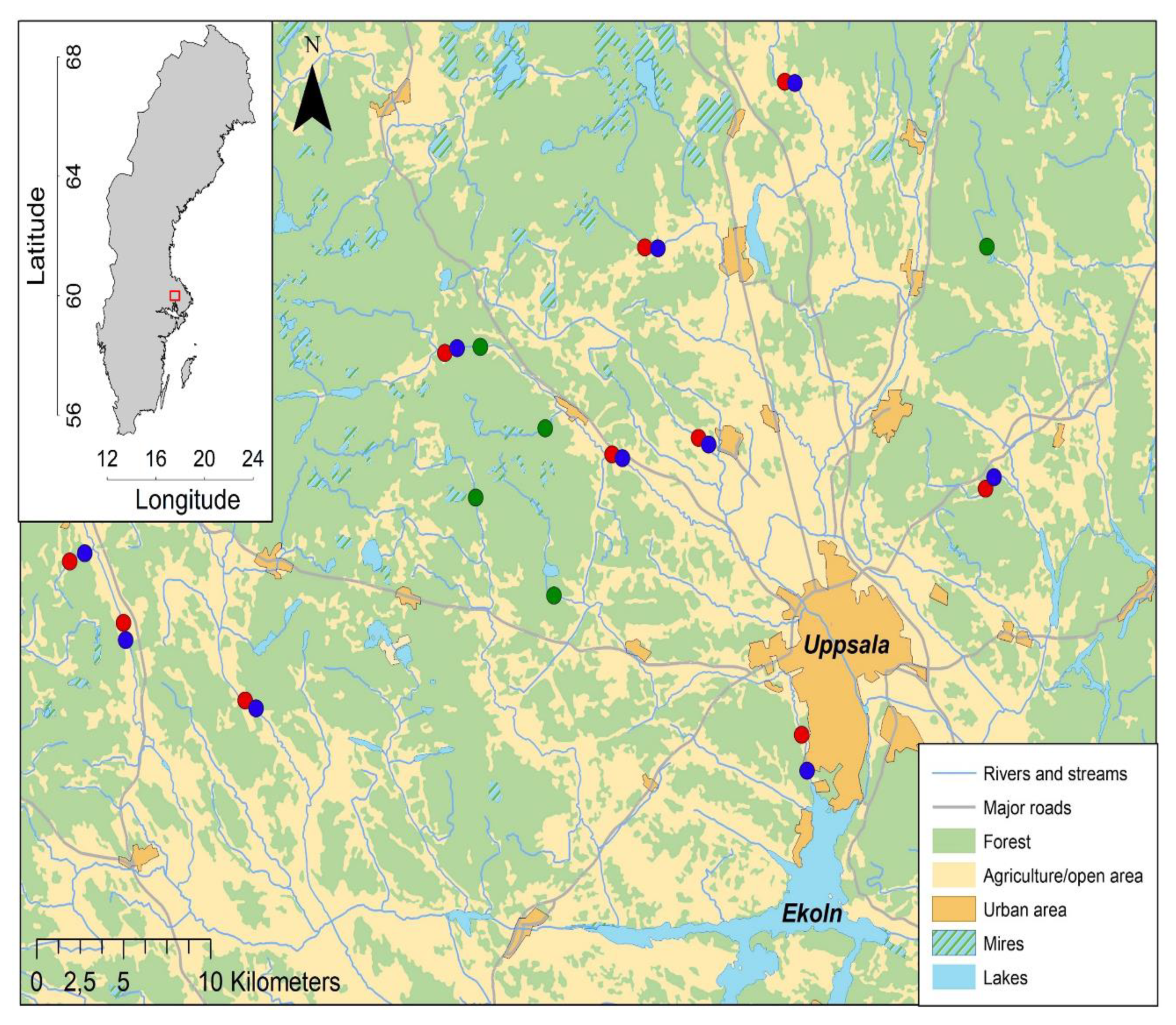
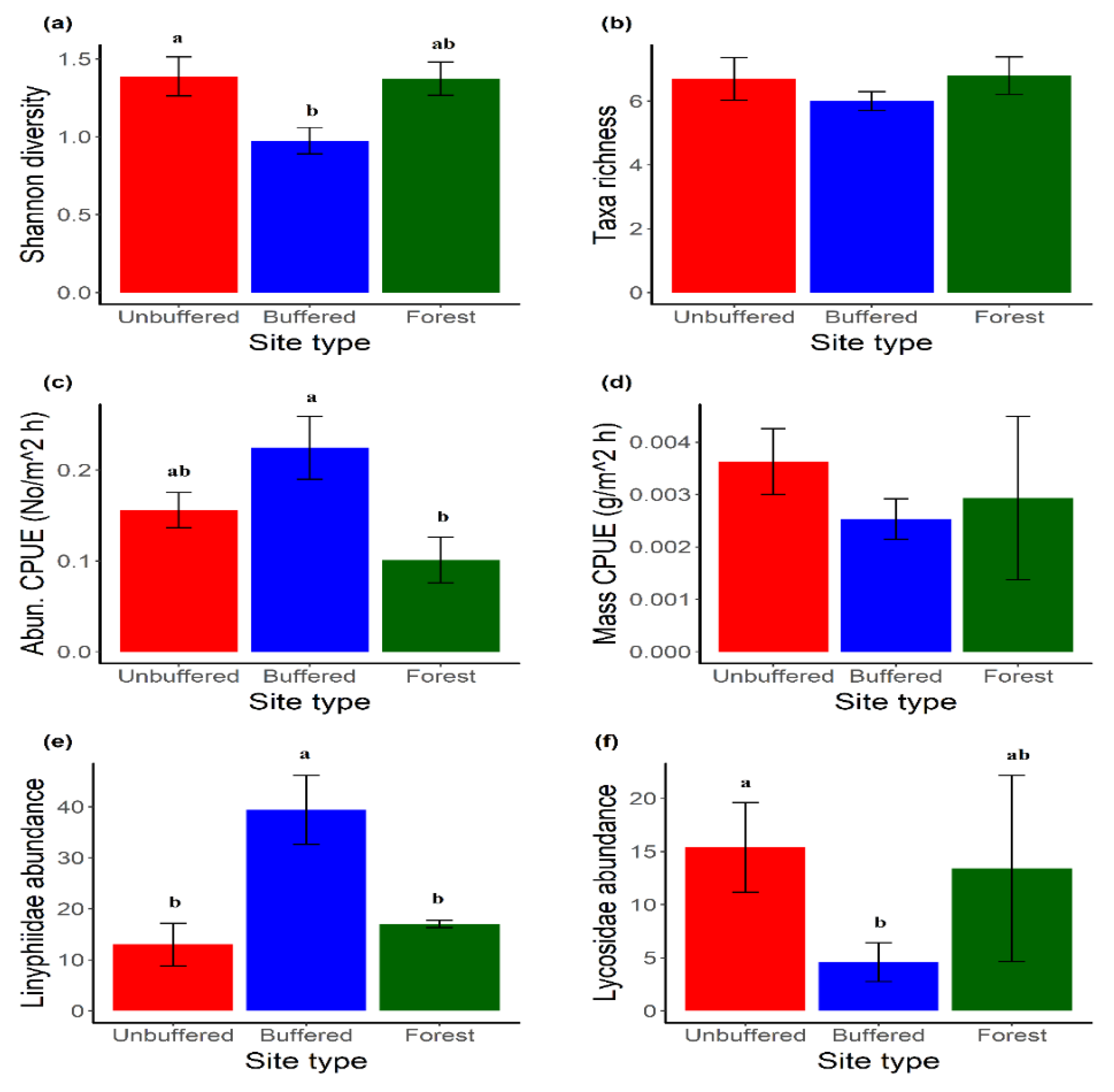
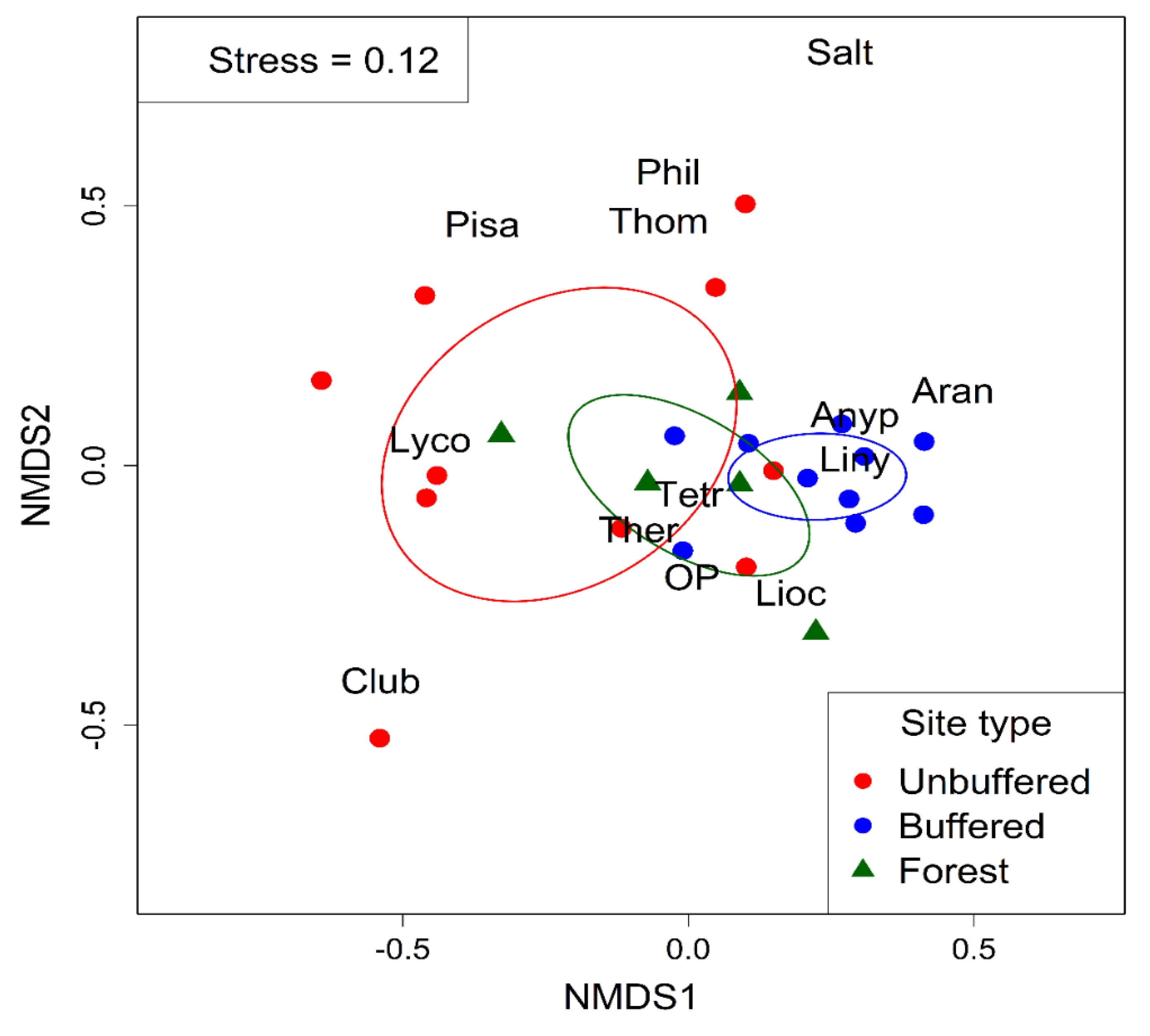
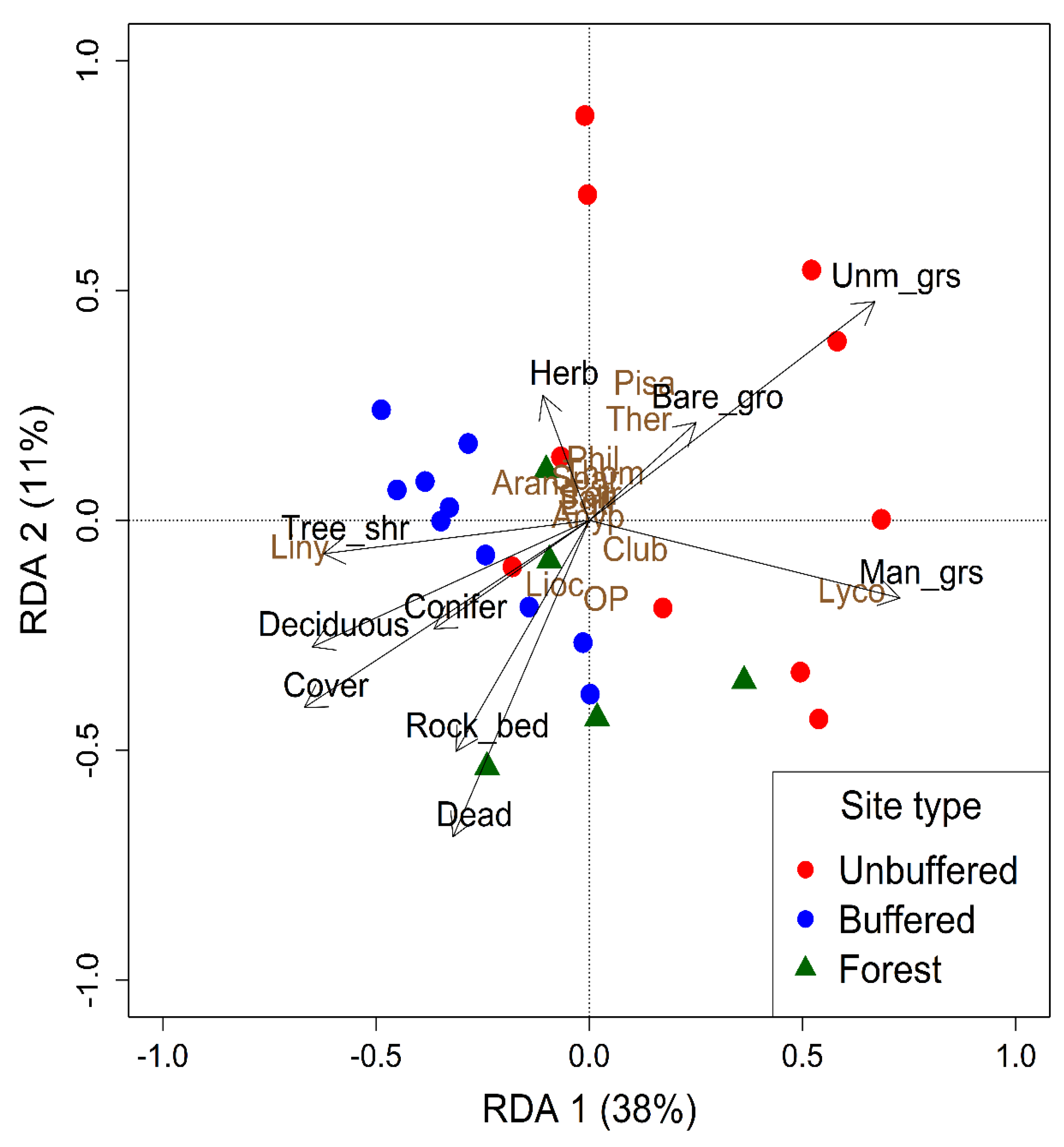
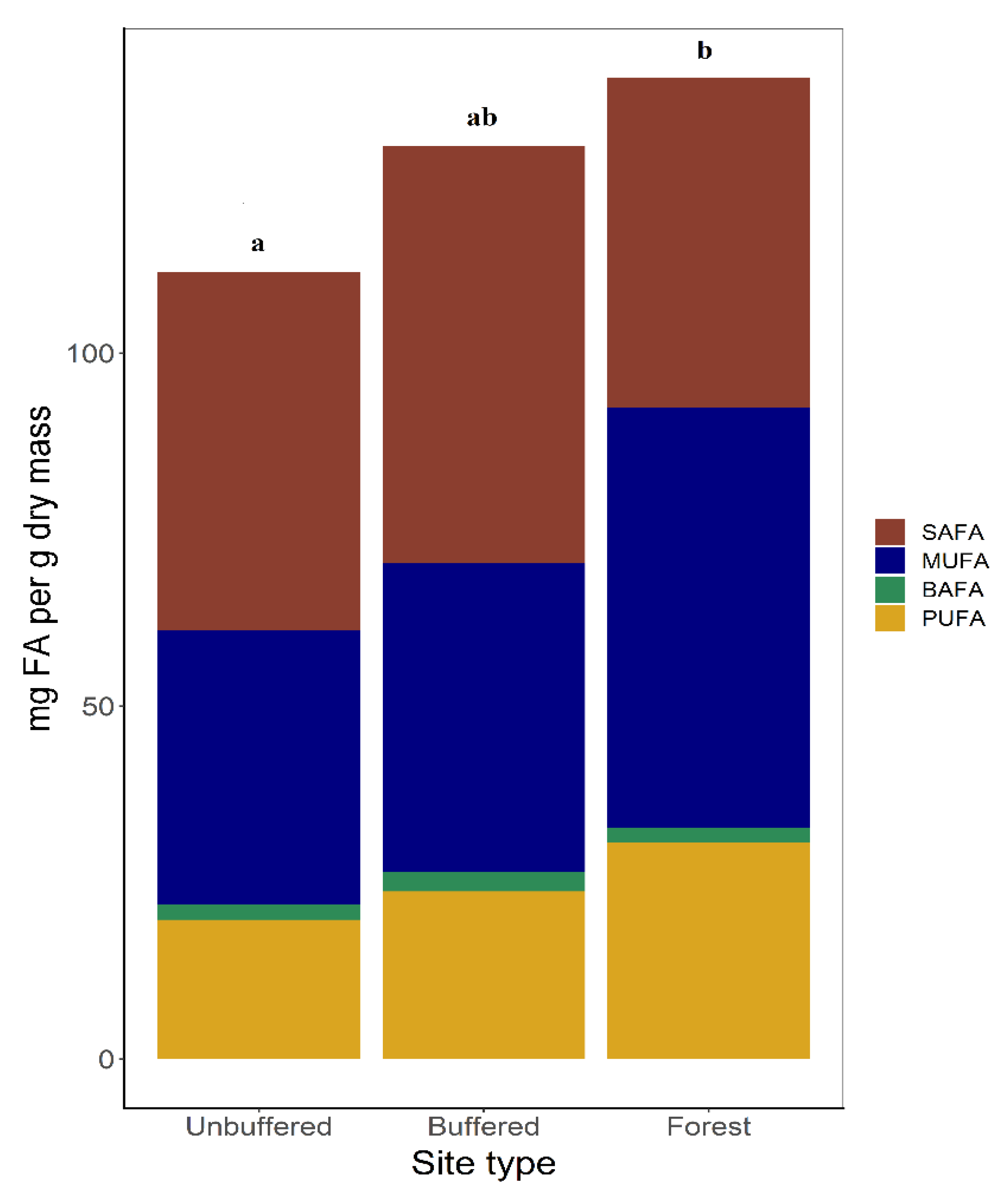
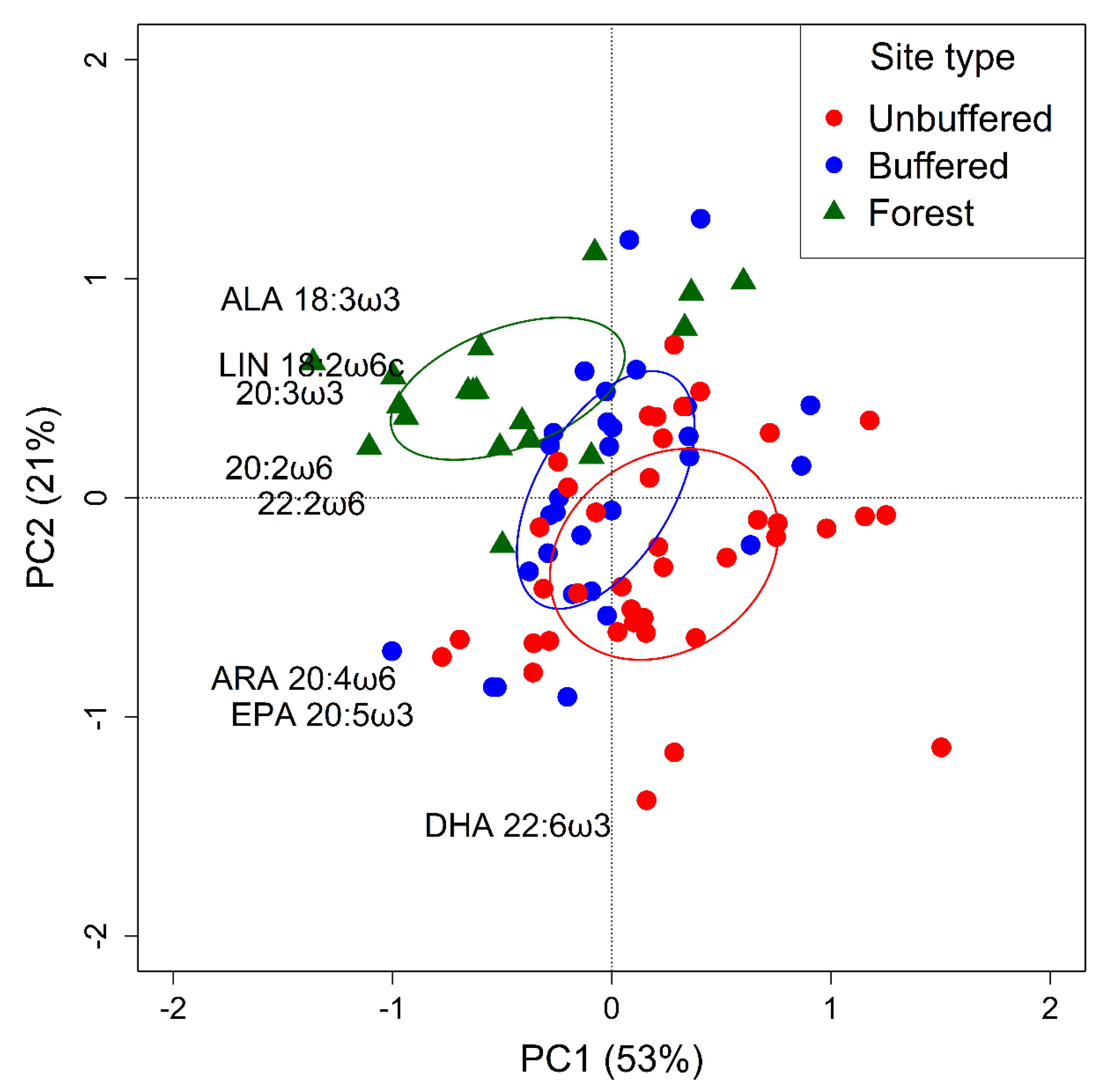

| Variable | Num. DF | Den. DF | F-Ratio | p-Value |
|---|---|---|---|---|
| PUFA % of FA | ||||
| Site type | 2 | 20 | 5.02 | 0.01 |
| Family | 4 | 57 | 4.73 | 0.002 |
| Site type × family | 8 | 57 | 2.51 | 0.02 |
| mg PUFA per g dry mass | ||||
| Site type | 2 | 16 | 10.43 | 0.001 |
| Spider family | 4 | 59 | 9.64 | <0.001 |
| Site type × family | 8 | 59 | 2.33 | 0.03 |
| Specific | Numerator | Denominator | F-Ratio | p-Value |
|---|---|---|---|---|
| PUFA | DF | DF | ||
| ALA 18:3ω3 | ||||
| Site type | 2 | 37 | 34.51 | <0.001 |
| Spider family | 4 | 64 | 7.15 | <0.001 |
| Site type × Spider family | 8 | 63 | 1.99 | 0.06 |
| LIN 18:2ω6c | ||||
| Site type | 2 | 42 | 6.73 | 0.003 |
| Spider family | 4 | 65 | 5.93 | <0.001 |
| Site type × Spider family | 8 | 64 | 1.83 | 0.09 |
| ARA 20:4ω6 | ||||
| Site type | 2 | 33 | 1.69 | 0.19 |
| Spider family | 4 | 63 | 21.74 | <0.001 |
| Site type × Spider family | 8 | 62 | 1.25 | 0.29 |
| EPA 20:5ω3 | ||||
| Site type | 2 | 33 | 1.98 | 0.15 |
| Spider family | 4 | 63 | 19.61 | <0.001 |
| Site type × Spider family | 8 | 63 | 0.85 | 0.56 |
| 20:3ω3 | ||||
| Site type | 2 | 31 | 49.54 | <0.001 |
| Spider family | 4 | 63 | 22.14 | <0.001 |
| Site type × Spider family | 8 | 62 | 1.59 | 0.14 |
| 20:2ω6 | ||||
| Site type | 2 | 40 | 10.66 | <0.001 |
| Spider family | 4 | 65 | 4.46 | 0.003 |
| Site type × Spider family | 8 | 64 | 1.89 | 0.32 |
| DHA 22:6ω3 | ||||
| Site type | 2 | 48 | 0.79 | 0.46 |
| Spider family | 4 | 65 | 8.10 | <0.001 |
| Site type × Spider family | 8 | 65 | 1.07 | 0.40 |
| 22:2ω6 | ||||
| Site type | 2 | 51 | 6.18 | 0.003 |
| Spider family | 4 | 66 | 8.79 | <0.001 |
| Site type × Spider family | 8 | 65 | 1.77 | 0.09 |
© 2020 by the authors. Licensee MDPI, Basel, Switzerland. This article is an open access article distributed under the terms and conditions of the Creative Commons Attribution (CC BY) license (http://creativecommons.org/licenses/by/4.0/).
Share and Cite
Ramberg, E.; Burdon, F.J.; Sargac, J.; Kupilas, B.; Rîşnoveanu, G.; Lau, D.C.P.; Johnson, R.K.; McKie, B.G. The Structure of Riparian Vegetation in Agricultural Landscapes Influences Spider Communities and Aquatic-Terrestrial Linkages. Water 2020, 12, 2855. https://doi.org/10.3390/w12102855
Ramberg E, Burdon FJ, Sargac J, Kupilas B, Rîşnoveanu G, Lau DCP, Johnson RK, McKie BG. The Structure of Riparian Vegetation in Agricultural Landscapes Influences Spider Communities and Aquatic-Terrestrial Linkages. Water. 2020; 12(10):2855. https://doi.org/10.3390/w12102855
Chicago/Turabian StyleRamberg, Ellinor, Francis J. Burdon, Jasmina Sargac, Benjamin Kupilas, Geta Rîşnoveanu, Danny C. P. Lau, Richard K. Johnson, and Brendan G. McKie. 2020. "The Structure of Riparian Vegetation in Agricultural Landscapes Influences Spider Communities and Aquatic-Terrestrial Linkages" Water 12, no. 10: 2855. https://doi.org/10.3390/w12102855
APA StyleRamberg, E., Burdon, F. J., Sargac, J., Kupilas, B., Rîşnoveanu, G., Lau, D. C. P., Johnson, R. K., & McKie, B. G. (2020). The Structure of Riparian Vegetation in Agricultural Landscapes Influences Spider Communities and Aquatic-Terrestrial Linkages. Water, 12(10), 2855. https://doi.org/10.3390/w12102855







